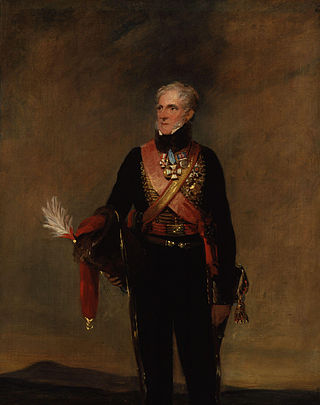
Thomas Phillips was a leading English portrait and subject painter. He painted many of the great men of the day including scientists, artists, writers, poets and explorers.

Sir David Wilkie was a Scottish painter, especially known for his genre scenes. He painted successfully in a wide variety of genres, including historical scenes, portraits, including formal royal ones, and scenes from his travels to Europe and the Middle East. His main base was in London, but he died and was buried at sea, off Gibraltar, returning from his first trip to the Middle East. He was sometimes known as the "people's painter".

Lemuel "Francis" Abbott was an English portrait painter, famous for his painting of Horatio Nelson, 1st Viscount Nelson and for those of other naval officers and literary figures of the 18th century.

Henry William Paget, 1st Marquess of Anglesey, styled Lord Paget between 1784 and 1812 and known as the Earl of Uxbridge between 1812 and 1815, was a British Army officer and politician. After serving as a member of parliament for Carnarvon and then for Milborne Port, he took part in the Flanders Campaign and then commanded the cavalry for Sir John Moore's army in Spain during the Peninsular War; his cavalry showed distinct superiority over their French counterparts at the Battle of Sahagún and at the Battle of Benavente, where he defeated the elite chasseurs of the French Imperial Guard. During the Hundred Days he led the charge of the heavy cavalry against Comte d'Erlon's column at the Battle of Waterloo. At the end of the battle, he lost part of one leg to a cannonball. In later life he served twice as Master-General of the Ordnance and twice as Lord Lieutenant of Ireland.

Daniel Maclise was an Irish history painter, literary and portrait painter, and illustrator, who worked for most of his life in London, England.

Sir William Allan was a distinguished Scottish historical painter known for his scenes of Russian life. He became president of the Royal Scottish Academy and was made a Royal Academician.

James Ward was an English painter, particularly of animals, and an engraver.
Sir William Charles Ross was an English portrait and portrait miniature painter of Scottish descent; early in his career, he was known for historical paintings. He became a member of the Royal Academy in 1842.
Events from the year 1767 in art.
William Salter was an English portrait painter of the 19th century. His best known work was a painting of 83 people at a banquet in 1836 organised by the Duke of Wellington to celebrate their victory at the Battle of Waterloo. The painting is called The Waterloo Banquet 1836 and today is at Apsley House.

William Sadler II, also known as William Sadler the Younger, was an Irish painter. He was a noted landscape painter who is remembered today for his depiction of the Battle of Waterloo.

George Jones was a British painter, and Keeper of the Royal Academy, most famous for his paintings of military subjects.

George Arnald was a British painter who specialised in landscapes, including topographical views to illustrated county histories. He is best known for his celebrated painting depicting the Battle of the Nile.

WilliamAnderson was a Scottish artist specialising in maritime and patriotic themes. He was well-regarded for his detailed and accurate portraits of ships under sail, exhibiting his works annually in London between 1787 and 1811 and then occasionally until 1834. Anderson influenced other artists, notably John Ward and others of the Hull school.

Georg Bleibtreu was a German painter of military and historical scenes.

Edward Francis Burney (1760–1848) was an English artist. His middle name is sometimes given as "Francisco" or "Francesco".

The Waterloo Chamber, dating from 1830–31, is a large room in Windsor Castle dedicated to the military defeat of the French Emperor Napoleon Bonaparte by British, Prussian, Russian, and Austrian forces under the command of the Duke of Wellington at the Battle of Waterloo.

Charles Wilkin, was an English engraver, painter and publisher who exhibited at the Royal Academy between 1783 and 1808, and is best known for his stipple engravings.

Henri Jean-Baptiste Victoire Fradelle (1778–1865) was a Franco-English Victorian painter and portraitist, specializing in literary, historical, and religious subjects. For more than a hundred years, he was confused with his son, Henry Joseph Fradelle (1805–1872), who was trained as an artist but had several professions, including infirmary supervisor. It was only in the first decade of the 21st century that this mistake was identified and that biographies, lists, and auction houses gave Fradelle his rightful name.

Frederick Richard Say was a notable society portrait painter in London between c. 1830 and c.1860, undertaking commissions for portraits of figures such as Earl Grey, Sir Robert Peel, the Duke of Wellington and the Royal family.


















